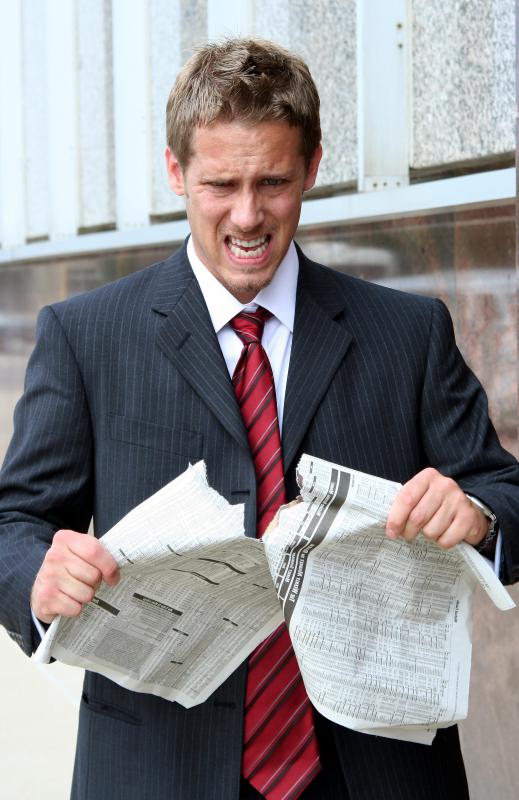At SmartCapitalMind, we're committed to delivering accurate, trustworthy information. Our expert-authored content is rigorously fact-checked and sourced from credible authorities. Discover how we uphold the highest standards in providing you with reliable knowledge.
What is Cyclical Unemployment?
Cyclical unemployment is a term in economics, which is based on a greater availability of workers than there are jobs for workers. It is usually directly tied to the state of the economy. Lower demand for products due to lack of consumer confidence, disinterest, or reduction in consumer spending results in the workforce cutting back on production. Since production is reduced, companies that retail such products may also cut back on workforce, creating yet more cyclical unemployment.
The reason this type of unemployment is called cyclical is because it is usually linked to a country’s business cycle, a system of evaluating how gross domestic product changes over time. Length of time is not always predictable in a business cycle, which includes four basic periods. At the beginning of a business cycle, a slowdown in economic activity occurs resulting in a sharp drop into a trough, which hits the lowest point of the economic cycle and would be linked to the highest unemployment rate. Gradually, through a variety of factors, pace of economic activity increases in the expansion period, and then the business cycle hits its peak, which translates to economic recovery and more available work.

Cyclical unemployment begins to occur during the first part of the business cycle and reaches its peak when the business cycle is in the bottom of the trough. As economic recovery begins, more jobs become available. When the business cycle peak is hit, there may be more jobs than there are workers, the opposite of cyclical unemployment.
Typically, business cycles are of short duration, but occasionally, long-term economic factors create not recession, but depression. This can mean that the actual time the economy sputters and falters can last for several years, creating severe unemployment for a long time period. When a country is in a depression, governments may act by lowering taxes and interest rates to improve consumer demand and spending, and also by creating jobs. In the Great Depression in the US, the government-created jobs ended part of the cyclical unemployment problem. More jobs were offered, and the economy really picked up at the onset of World War II.

Other factors can create unemployment of this kind. When work traditionally done inside a country is outsourced, this can heighten unemployment rates. Until workers can be retrained for other positions or find jobs where demand still remains high, they may experience long periods of unemployment.
Cyclical unemployment may also be defined as a negative correlation between Gross Domestic Product (GDP) and unemployment rate. As Gross Domestic Product shrinks, unemployment rate expands. It has an impact on the ability for an economy to recover, since fewer jobs create less consumer spending, and less demand. It also creates higher government spending in order to help those people who require unemployment checks, and welfare or financial assistance. Usually, economic recovery does begin, but how it does so can vary with each business cycle. Therefore this type of unemployment is considered temporary, at least in economic recession, and based on the economic cycle, it will tend to cease over time when the economy moves out of the business cycle trough and begins to climb into recovery and then to its peak.
AS FEATURED ON:
AS FEATURED ON:















Discussion Comments
If you had to come up with a concise answer to the question, "Cyclical unemployment results from...", what would you say?
I have this essay topic, and I'm supposed to use that question as my first sentence, with four major causes listed afterward.
Oh, also, is it correct to refer to those who become unemployed during a period of cyclical unemployment as the "cyclically unemployed"?
Is there a good, short way to put this? I'm not really up on my economics terms, so I would really appreciate the help! Thanks!
How would you define a cyclical unemployment rate? Do they just use the same kind of definitions that they would for regular unemployment rates, or is it determined in a different way?
I'm writing a paper on cyclical unemployment, and when I googled "definition of cyclical unemployment", it led me here, which was so, so helpful. Now all I need to know is about the way the cyclical rate of unemployment is determined. Do you know?
Would you say that the US is going through a period of cyclical unemployment now as the Great Recession sets in?
I know it's a little different from the cyclical unemployment examples mentioned above in the article, but do you think that you could reasonably consider the current unemployment situation to be an example of cyclical unemployment as well?
Post your comments